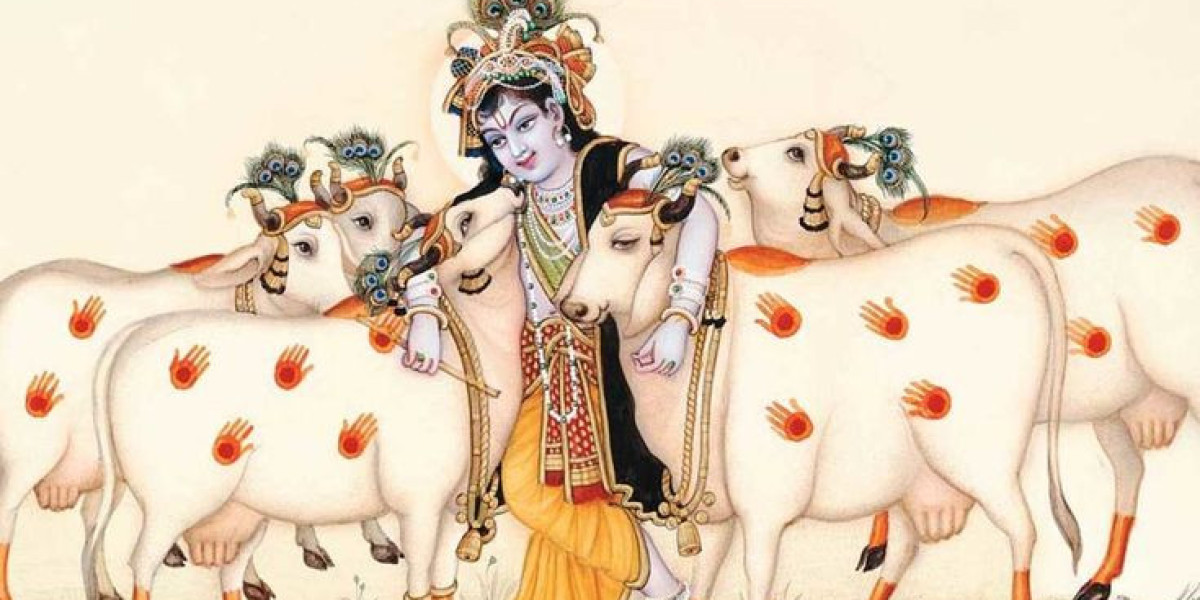The spiritual traditions of Sanatana Dharma highlight deep connections between the divine, nature, and animals. Among the most revered relationships is the sacred bond between Lord Krishna, Lord Ganesha, and Gaumata (Mother Cow). Each of these divine figures carries symbolic meaning that inspires devotees to embody values like compassion, wisdom, and harmony. In Hinduism, Krishna, Ganesha, and the cow are interconnected through mythological tales, rituals, and festivals, reflecting ideals of coexistence between humans, animals, and nature. This bond teaches profound life lessons while reminding us of the importance of reverence for all living beings.
This article delves into the divine relationship between Krishna, Ganesha, and Gaumata, explaining its spiritual and cultural significance.
Lord Krishna and Gaumata: The Eternal Bond
Lord Krishna, often depicted as a playful cowherd in Vrindavan, shares an inseparable connection with Gaumata. His childhood was filled with moments spent herding, nurturing, and playing among cows, establishing him as Gopala (the protector of cows). This divine connection emphasizes the importance of animals in human life and teaches lessons of care, protection, and humility.
Spiritual Significance of Krishna’s Love for Gaumata
Symbol of Love and Harmony with Nature
Krishna’s relationship with cows represents harmony between humans and animals. He encourages his devotees to treat all beings with love and compassion. Cows, in particular, symbolize nourishment and abundance, providing milk and other essentials for sustenance.Krishna as Gopala: Protector of Cows
Krishna’s role as a protector and caretaker of cows reflects the duty of human beings to safeguard nature and animals. His life reminds us that animals should not be exploited but rather cherished as an integral part of our existence.Govardhan Puja: Honoring Krishna and Gaumata
The Govardhan Puja, performed during Diwali, celebrates Krishna’s protection of Vrindavan by lifting Govardhan Hill. As part of this ritual, devotees worship cows and offer them food, acknowledging the interdependence between nature, animals, and humans.
Lord Ganesha and Gaumata: A Symbol of Compassion and Wisdom
Lord Ganesha, known as the remover of obstacles and the god of wisdom, also shares a sacred connection with Gaumata. Ganesha’s association with animals is well-known—he is depicted with an elephant head, rides a mouse as his vehicle, and is revered for his ability to maintain balance between the divine and earthly realms. His bond with Gaumata underscores the importance of selfless service, knowledge, and compassion.
Lessons from the Bond Between Ganesha and Gaumata
Symbol of Unity and Balance
Ganesha’s association with various animals—including the cow—symbolizes the unity of all creatures in the cosmic order. Gaumata, as the embodiment of nurturing and giving, complements Ganesha’s qualities of wisdom and problem-solving, reminding us to approach life’s challenges with both intellect and kindness.Ganesha and Eco-Friendly Practices
During Ganesh Chaturthi, clay idols of Ganesha are immersed in water bodies to symbolize the cycle of birth, life, and dissolution. In traditional practices, cow dung and natural materials are used to create eco-friendly idols, promoting sustainability and respect for the environment.Compassion as the Path to Wisdom
The bond between Ganesha and Gaumata teaches that true wisdom comes from compassion. Just as Gaumata selflessly nourishes, Ganesha encourages individuals to help others without expecting anything in return.
The Role of Gaumata in Hindu Spirituality
Gaumata (the sacred cow) occupies a revered place in Sanatana Dharma. She symbolizes motherhood, abundance, and purity, providing essential products like milk, curd, ghee, and dung. Gaumata’s presence in festivals, rituals, and mythology reflects her importance in maintaining ecological balance and spiritual well-being.
The Spiritual and Ecological Significance of Gaumata
Embodiment of the Earth’s Nurturing Energy
Gaumata is seen as a manifestation of the Earth’s nurturing spirit, offering sustenance without discrimination. Her products are used in sacred rituals such as yajnas, where ghee is offered to the fire to purify the environment and invoke divine blessings.Cow Dung as a Sacred Resource
Cow dung is not merely waste; it is considered sacred and used in various ways—ranging from fertilizing soil to creating eco-friendly fuel. It is also molded into cakes for rituals, symbolizing sustainability and respect for nature’s gifts.A Symbol of Non-Violence and Compassion
In Hinduism, the cow is associated with the principle of ahimsa (non-violence). Serving and protecting cows is believed to cleanse one’s karma and cultivate inner peace and spiritual growth.
The Divine Triad: Krishna, Ganesha, and Gaumata
The sacred relationship between Krishna, Ganesha, and Gaumata is not just a part of mythology—it reflects profound spiritual truths and offers practical lessons for daily living. These figures represent the harmony between wisdom, love, and nature.
Interdependence and Balance
Krishna’s love for Gaumata and Ganesha’s association with animals symbolize the interconnectedness of all life forms. These relationships teach us that humans, animals, and nature are dependent on one another for survival and spiritual growth.Sustainability and Environmental Awareness
The bond between these divine figures encourages individuals to adopt eco-friendly practices and live in harmony with nature. Festivals like Govardhan Puja and Ganesh Chaturthi emphasize sustainable traditions, using natural products like cow dung, clay, and organic offerings.Compassion and Wisdom as Life’s Guiding Principles
Krishna, Ganesha, and Gaumata exemplify the virtues of love, compassion, and wisdom. Their stories inspire people to nurture relationships, care for animals, and approach life’s challenges with intelligence and empathy.
The Relevance of this Sacred Bond in Modern Times
In today’s fast-paced world, the lessons from the sacred bond between Krishna, Ganesha, and Gaumata are more relevant than ever. Their relationship encourages people to reconnect with nature and adopt sustainable living practices.
Promoting Animal Welfare
The reverence for Gaumata inspires efforts to protect cows and animals through Gaushalas and ethical practices. Supporting animal welfare reflects the value of compassion in action.Encouraging Sustainability
By using eco-friendly products like cow dung for fuel and clay for idols, these traditions advocate for sustainable practices that benefit the environment and reduce pollution.Cultivating Compassion and Mindfulness
In a world driven by materialism, the teachings of Krishna, Ganesha, and Gaumata encourage individuals to live with mindfulness, empathy, and gratitude. Embracing these values fosters inner peace and spiritual growth.
Conclusion: A Timeless Relationship of Love and Wisdom
The sacred bond between Krishna, Ganesha, and Gaumata offers valuable insights into the spiritual, ecological, and cultural essence of Sanatana Dharma. This divine relationship reflects the interconnectedness of all life forms, teaching us to approach life with compassion, intelligence, and harmony.
In Krishna, we see the ideal of love and protection; in Ganesha, the embodiment of wisdom and problem-solving; and in Gaumata, the symbol of selfless service and sustenance. Together, they inspire individuals to care for animals, live sustainably, and nurture meaningful relationships.
Their teachings remain relevant today, offering solutions for environmental challenges and guiding us toward a life of peace, balance, and fulfillment. Through festivals, rituals, and daily practices, the bond between Krishna, Ganesha, and Gaumata continues to remind us of the importance of living in harmony with nature and embracing divine wisdom in every aspect of life.
For more insights on this sacred bond, read the complete article here.







